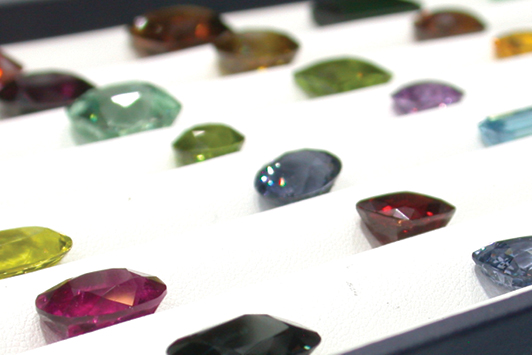
There once was a Silk Road — the ancient Asian trading route that introduced the West to tea, silk and spices. Today, jewelry buyers continue to head east for their trade, flocking to Asia’s multiple fairs each year to view loose gemstones and finished goods up close and personal.
For chain stores, shopping channels and e-commerce vendors who do volume, this can be a lucrative business decision. By going to the source, they can make deals and purchase products that would not otherwise be a possibility. But for smaller operations, such as American designers and independent retailers, the question remains: Does it make business sense to venture abroad and purchase direct?
Many who have shopped at any of the Hong Kong trade shows can attest to the fairs’ addictive qualities. Gem Shopping Network’s Alex Beamon says he feels like “Indiana Jones in a super Costco — there is so much quality and variety.” Everything, he says, is in one place, and you’re certain to find “loose and finished colored-gemstone jewelry at the best price.”
There are certainly no shortages of jewelry and gem shows in Asia, although the Hong Kong Trade Development Council (HKTDC) organizes two of the largest shows, which take place at the end of February. The Hong Kong International Jewellery Show (for finished goods) and the Hong Kong International Diamond, Gem & Pearl Show (for loose gems and pearls) attracted a combined total of 85,000 buyers from 144 counties and regions this year, with roughly 5.6% of attendees coming from North America.
“This is the place where trends are born,” says Beamon. “If you don’t follow trends, don’t bother with the 16-hour plane ride. Go to Vegas instead.”
It’s the proximity to the source that seems to entice jewelers, as well as the thrill of discovery. When it comes to gemstones, many American retailers are still searching for the “big three” — ruby, emerald and sapphire — as well as hot new finds. But don’t expect low prices, especially for quality merchandise, just because you’re near the famed mines and cutting centers of Asia. Barbara Wheat, the newly appointed president of the Bangkok-based Asian Institute of Gemological Sciences (AIGS), says bargain shopping abroad isn’t always realistic.
“Some buyers might feel that getting closer to the source brings them a better price. However, quality stones carry a similar price no matter where they are purchased,” she says. As with fruit that’s ripe for picking, some jewelers and designers travel to Asia to find the extraordinary gemstones that simply won’t make it from one show to the next. Los Angeles-based designer Erica Courtney says she shops Asian shows for exotic gems, ones that incite the “wow” factor for her high-end clientele. She might find those stones at Tucson’s AGTA GemFair, the HKTDC shows or Thailand’s Bangkok Gems & Jewelry Fair.
“Beautiful gems will appear when they’re ready, and I’ll scoop them up,” she says. What moves her customers? “Right now, they’re excited about Tanzania’s Mahenge garnets and spinels. The garnets come in luscious shades of ‘pinky orange,’” says Courtney. “And the spinels sparkle in shades from peach to lavender.”
Could she find such gems in Tucson? “Possibly,” she says, “but you will have different availability from one show to the next. And I like to shop.”
It’s also important to realize that some gems may never leave Asia, as better goods are expensive to transport. That’s why buying trips may be worth the effort for American retailers, as they can view merchandise they wouldn’t normally see in the United States, says Gary Roskin, executive director of the New York-based International Colored Gemstone Association (ICA).
“Large rubies, emeralds and sapphires may not make it here due to the cost of transporting high-value gems,” he says. “The same goes for large lots of calibrated stones. To travel all this way and carry goods with smaller value isn’t worth the expense.”
He notes that jewelers can also see gems that aren’t as popular in the United States at Asian shows, including Australian black opals and jadeite.
Of course, there are potential drawbacks to buying in Asia. Adam Graham, director of sales and marketing for Omi Gems in West Covina, California, says buying in Hong Kong might put American retailers on less-than-firm footing as far as merchandise guarantees are concerned.
“Hong Kong is an attractive hub for trading, with its free-trade-zone designation for suppliers from all over Asia and the world,” he says. But Graham urges retailers to take a “buyer beware” attitude. “Unlike the AGTA GemFair, where all purchases are protected by the AGTA, the Hong Kong shows are more like the wild west.”
Buyers are expected to pay in cash for purchases, unless an account status has been set up in advance. Combined with the cost of travel, Graham says, a journey to Hong Kong may not be justified in terms of savings, “unless you are buying large volumes and have cash in hand to do so.”
Image: ICA member Charles Abouchar displays the "big three", as well as lagoon beryl, aquamarine, green garnets, spinels, and tanzanites. aboucharsa.chArticle from the Rapaport Magazine - September 2017. To subscribe click here.